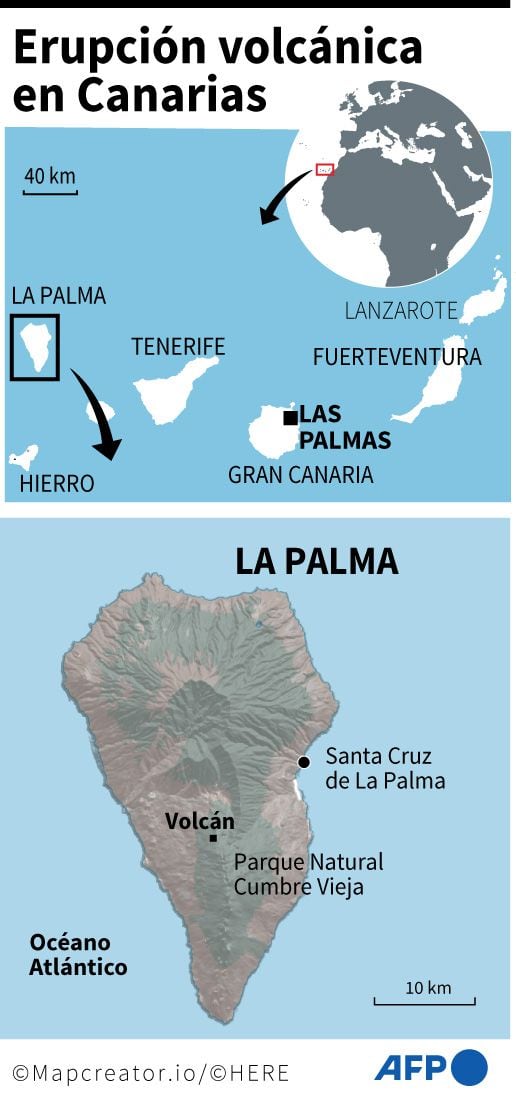The new rupture of the main cone of the La Palma volcano that occurred this Wednesday maintains the flow of lava towards the west of the Spanish island, where there is also growing concern about the emissions of sulfur dioxide (SO2) from the volcanic plume, which oscillate between 6,000 and 9,000 tons per day. In recent hours, earthquakes of magnitude greater than 3.5 at medium and deep depths -more than 20 kilometers- have increased in La Palma, which increases the chances of an earthquake of intensity VI (slightly damaging ), according to what the Department of Homeland Security (DSN) said on Thursday.
It also notes that the new rupture of the main cone of the Cumbre Vieja volcano it maintains the lava flow towards the west, feeding the already existing flows.
A few minutes ago the cone broke and caused more lava overflows and landslides that have generated air currents #lapalma pic.twitter.com/1fRNovxJ3c
— INVOLCAN (@involcan) October 25, 2021
On the other hand, and in view of the possible new arrival of lava to the sea, the Maritime Captaincy has established an exclusion perimeter from the south (Puerto Naos) to the north (Tazacorte) and parallel to the coast half a nautical mile from the coast.
LOOK: The lava from the La Palma volcano reaches the sea and generates toxic gases | PHOTOS
With regard to air quality, the DSN reported that the eruptive process has increased sulfur dioxide (SO2) values on the west side of the island, where the volcano could be emitting up to 9,000 tons per day of this gas into the atmosphere.
Early this Thursday the weather scenario continued to be favorable for airport operations on the island of La Palma.
SIGHT: LIVE | The cone of the La Palma volcano breaks and leaves a huge wash towards the sea | PHOTOS
The island of The Palm have experienced in the last 24 hours more than a hundred new earthquakes, according to information from the National Geographic Institute, which details that the largest earthquake of those registered since midnight (local time) occurred at 5:05 a.m. in Fuencaliente, with a magnitude of 3.6 and an intensity estimated at III (weak).
A few hours earlier, at 01:25, the seismographs detected in Villa de Mazo, another movement of magnitude 3.5, in this case with a greater intensity: IV or “widely observed” (felt inside buildings by many and only by very few outside; slight shaking or shaking of the building, room or bed; knocking of dishes, glassware, windows and doors and no damage).
SIGHT: The dangerous chemical reaction that will occur when lava from the La Palma volcano reaches the ocean
All movements detected during the night (between 00:00 and 6:30) have occurred at depths of between 10 and 14 kilometers.

________________________________
- Pandora Papers: investigation reveals 35 world leaders hid their fortune to avoid paying taxes
- Melbourne becomes the city in the world with the most days under strict confinement due to coronavirus
- Why New Zealand Decided To Abandon Its “Successful” Coronavirus Total Elimination Strategy (And What’s New)
- A Romanian millionaire among the 8 killed by a private plane crash against a building in Milan | PHOTOS
- Ecuador’s President Guillermo Lasso created an ‘offshore’ network to hide his fortune, according to the Pandora Papers
- Simple guide to understanding Pandora Papers, one of the biggest leaks in history
- The Romanovs and the lineage of the last tsars: what was the fate of the descendants of the royal family of Russia?
.

:quality(75)/cloudfront-us-east-1.images.arcpublishing.com/elcomercio/M4V5EKAR3NHAPBQJ4JIA5EWJC4.jpg)





